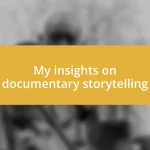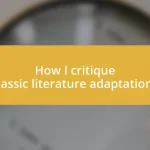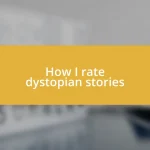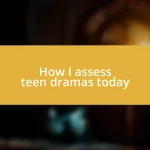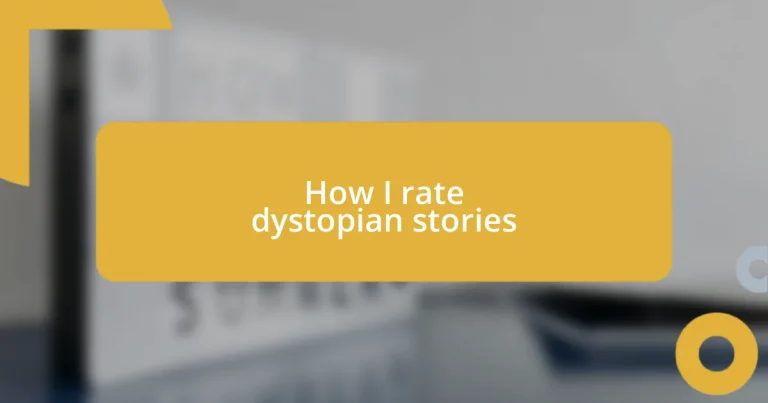Key takeaways:
- Dystopian stories evoke emotional responses by exploring themes of fear, oppression, and resistance, prompting readers to reflect on their own societal roles and actions.
- Key elements of dystopian fiction include an oppressive authority, a bleak setting that mirrors character struggles, and protagonists representing resistance, all crucial for evaluating the narrative.
- Character development and world-building are essential in dystopian literature, enhancing emotional engagement and allowing exploration of moral dilemmas and personal growth.
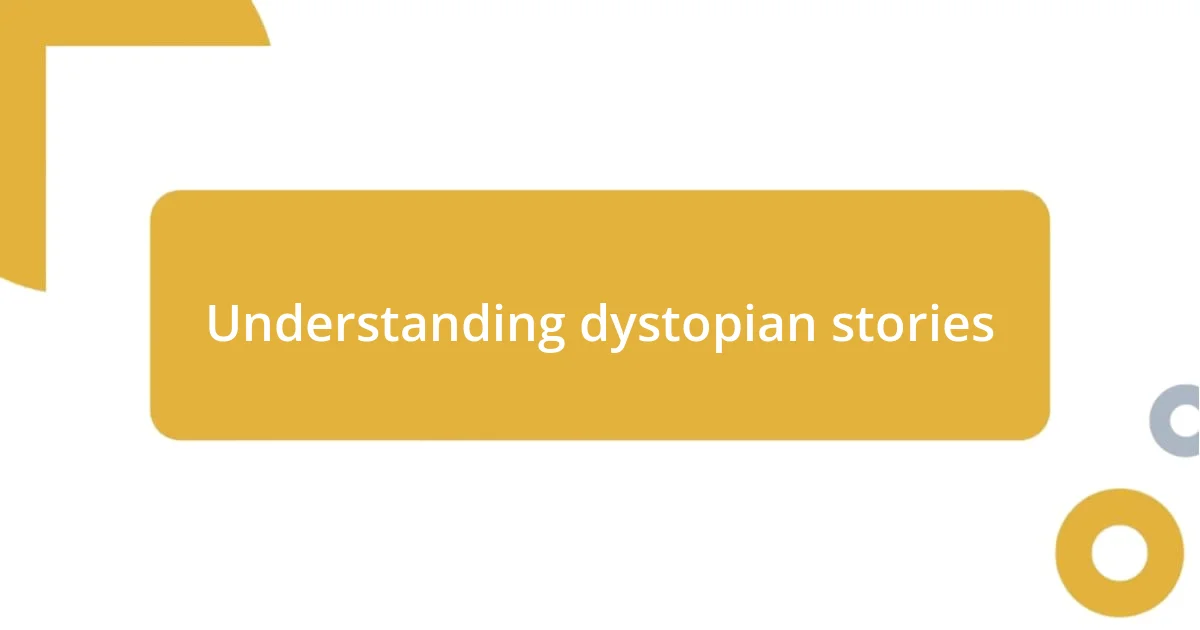
Understanding dystopian stories
Dystopian stories often explore the darker facets of society and human nature, presenting worlds where fear and oppression prevail. I remember reading 1984 by George Orwell for the first time, and it struck me how closely it mirrored certain aspects of our reality. Have you ever felt that chilling sensation when fiction seems all too possible?
These narratives create a palpable tension, engaging us in questions about humanity and morality. For instance, in The Handmaid’s Tale by Margaret Atwood, the emotional weight of systemic oppression makes readers examine their own society’s norms. It’s almost as if we’re compelled to reflect: How much control do we really have over our lives, and what does it mean to fight back?
I find that dystopian literature evokes a unique blend of fear and fascination. Each story invites us to envision potential futures shaped by current choices. It’s thrilling yet unsettling—doesn’t it make you wonder how our present actions could dictate tomorrow’s realities?
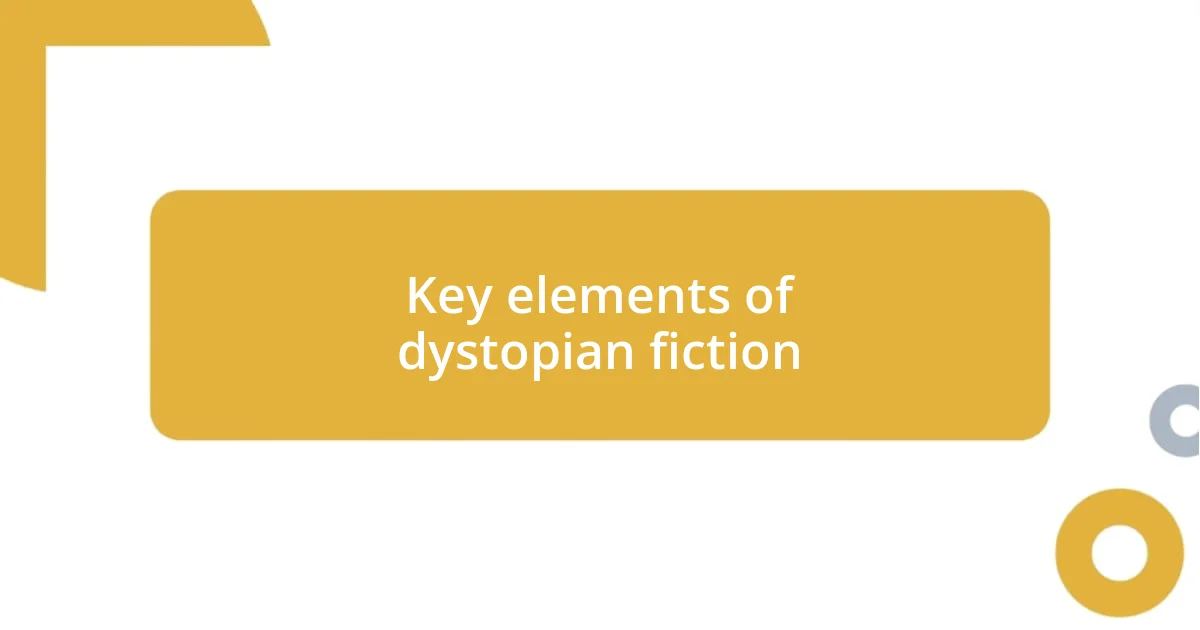
Key elements of dystopian fiction
Dystopian fiction thrives on a set of key elements that amplify its themes of fear and control. One core aspect is the oppressive government or authority that manipulates citizens, often mirroring the stark realities in our own lives. I’ll never forget the unease I felt while reading Fahrenheit 451 by Ray Bradbury; the idea of censorship resonated deeply with me. It made me question how much information we’re deprived of in our everyday lives.
Another vital element is the representation of a bleak setting, which reflects the emotional state of its characters. The grim landscapes often serve as metaphors for characters’ inner struggles. I vividly recall the suffocating atmosphere in The Road by Cormac McCarthy, where every desolate description seemed to whisper the fragility of hope. It made me think about how environment shapes our perceptions and behaviors in times of crisis.
Finally, dystopian narratives often include a protagonist who embodies resistance or rebellion against the oppressive system. This character’s journey can be incredibly inspiring. When I read Divergent by Veronica Roth, I found myself rooting for Tris and her fight against conformity. It sparked thoughts about my own life: how far would I go to challenge societal norms? These stories encourage us to consider our roles in fighting against oppression, even in the simplest forms.
| Key Element | Description |
|---|---|
| Oppressive Authority | Manipulates and controls citizens, often reflecting real societal issues. |
| Bleak Setting | Represents characters’ struggles and emotions, influencing their actions. |
| Protagonist’s Resistance | Embodies the fight against oppression, inspiring readers to reflect on their own roles. |
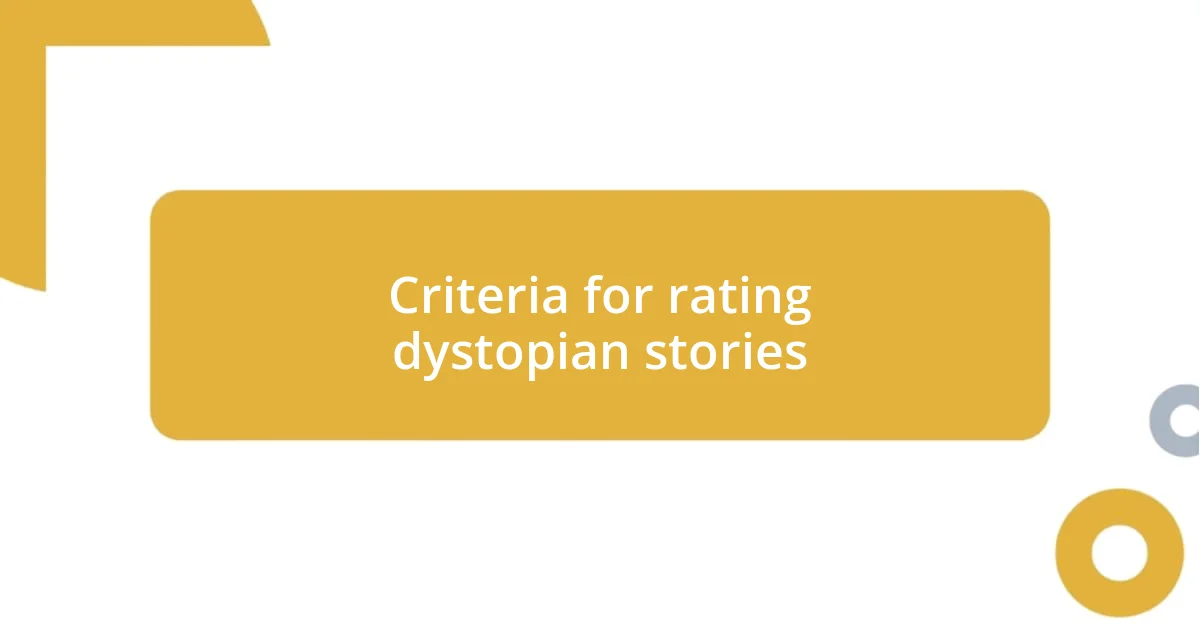
Criteria for rating dystopian stories
When I consider the criteria for rating dystopian stories, I focus on several key components that truly elevate the narrative. For me, the depth of world-building stands out the most. A well-crafted dystopian setting allows readers to feel the weight of despair and fear; it should be a character in its own right. I distinctly remember feeling overwhelmed by the stark, oppressive atmosphere in The Water Knife by Paolo Bacigalupi. The world felt all too real, reminding me of the dire implications of climate change we face today.
Here are the main criteria I evaluate when rating these stories:
- World-Building: Is the setting immersive and believable? Does it resonate with current societal issues?
- Character Development: Are the characters multi-dimensional, and do their arcs reflect growth or resistance?
- Themes and Messages: Do the themes provoke thought and discussion about society, morality, and human nature?
- Emotional Impact: Does the story evoke strong feelings, making me reflect on both the narrative and my personal beliefs?
- Pacing and Structure: Is the story engaging from start to finish, maintaining a rhythm that keeps me invested?
Examining these aspects helps me gain a deeper appreciation for how each element works together to create a powerful narrative. For instance, while reading Station Eleven by Emily St. John Mandel, I felt an incredible sense of loss interwoven with hope. The story’s ability to balance desolation with the fragility of human connection is what keeps me coming back to dystopian tales. Do you find yourself reflecting on these elements too?
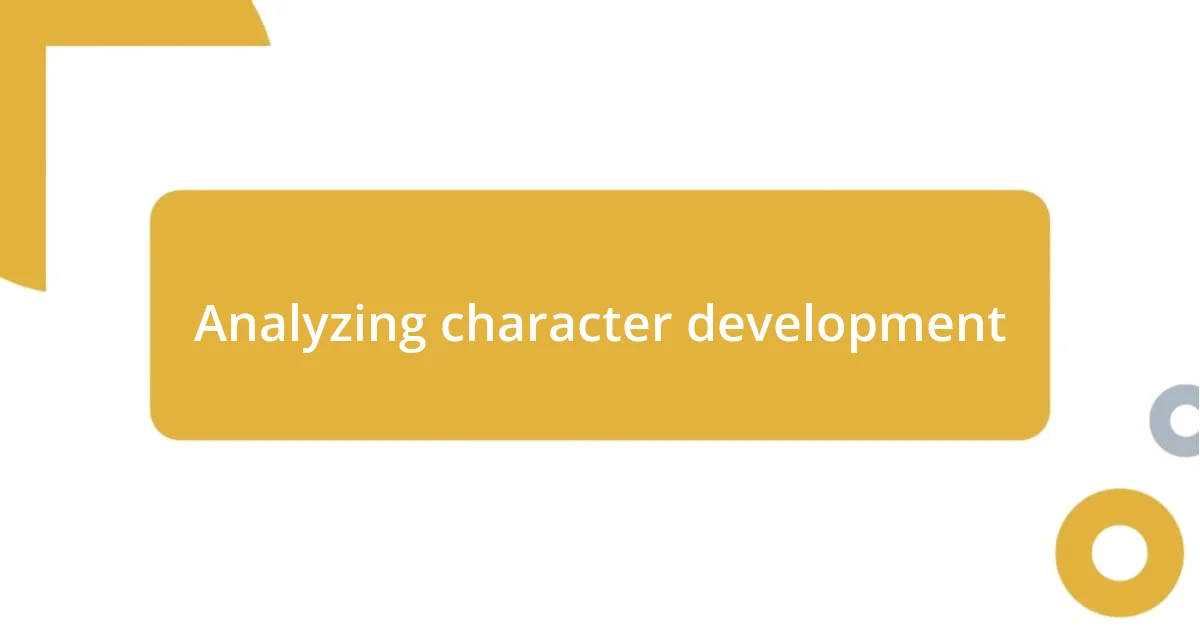
Analyzing character development
Character development is paramount in dystopian stories, as it brings life to bleak narratives and helps readers connect with the characters on a deeper level. I remember feeling profoundly moved by the transformation of Offred in The Handmaid’s Tale by Margaret Atwood. Her journey from a muted existence to a voice of resistance made me reflect on my own strength in challenging oppressive circumstances. It’s remarkable how the growth of a character can serve as a reflection of our own potential for change.
As I analyze character arcs, I look for authenticity in the struggles they face. In The Power by Naomi Alderman, the characters grapple with the sudden shift in their societal roles, forcing them to confront their own moral dilemmas. I found myself questioning how I would react in similar situations. Would I rise to the occasion, or would I falter under that immense pressure? Authenticity makes their development relatable and offers a mirror to our own societal dynamics.
Moreover, the interplay between characters and their environment often illuminates their inner growth. When I read Never Let Me Go by Kazuo Ishiguro, I was struck by how the characters’ identities were shaped by their dystopian reality. Their acceptance of fate versus their desire for agency left me contemplating the delicate balance between resignation and rebellion. I wonder, how much are we shaped by the circumstances around us? In dystopian fiction, character development becomes a vessel for exploring profound questions about identity and choice.
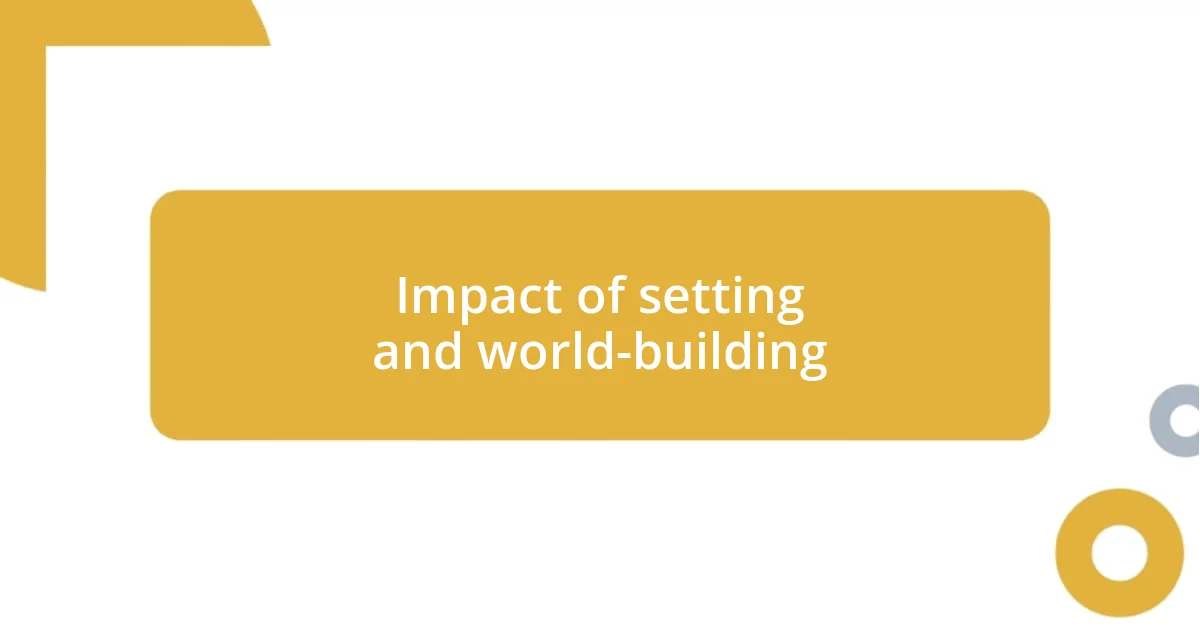
Impact of setting and world-building
World-building in dystopian stories is like setting the stage for a powerful play; it dictates the emotions we feel and the weight of the narrative. When I read Fahrenheit 451 by Ray Bradbury, the oppressive society where books are banned hit me hard. It was as if I could feel the suffocating heat of censorship permeating every page, and that visceral connection is what makes a setting unforgettable.
I often find myself captivated by how intricate details of a world can evoke real-world parallels. For example, in The Road by Cormac McCarthy, the bleak and desolate landscape reflects the fragility of civilization. I remember sitting in my cozy living room, yet feeling an intense chill as the imagery of ash-covered ruins hung like a dark cloud over my thoughts. Does the setting force you to consider the future of our own world? It certainly does for me.
Moreover, an effective dystopian setting can heighten the emotional stakes for its characters. In The Handmaid’s Tale, the rigid societal structures create an atmosphere of tension that seems to pulse with each scene. I vividly recall feeling a mix of anger and sympathy for the characters trapped within those confines. World-building serves as the encompassing box that not only contains the characters but also shapes their choices and highlights their struggles. How often do we ponder the influence of our surroundings on our own decisions? In dystopian narratives, this question becomes even more poignant.
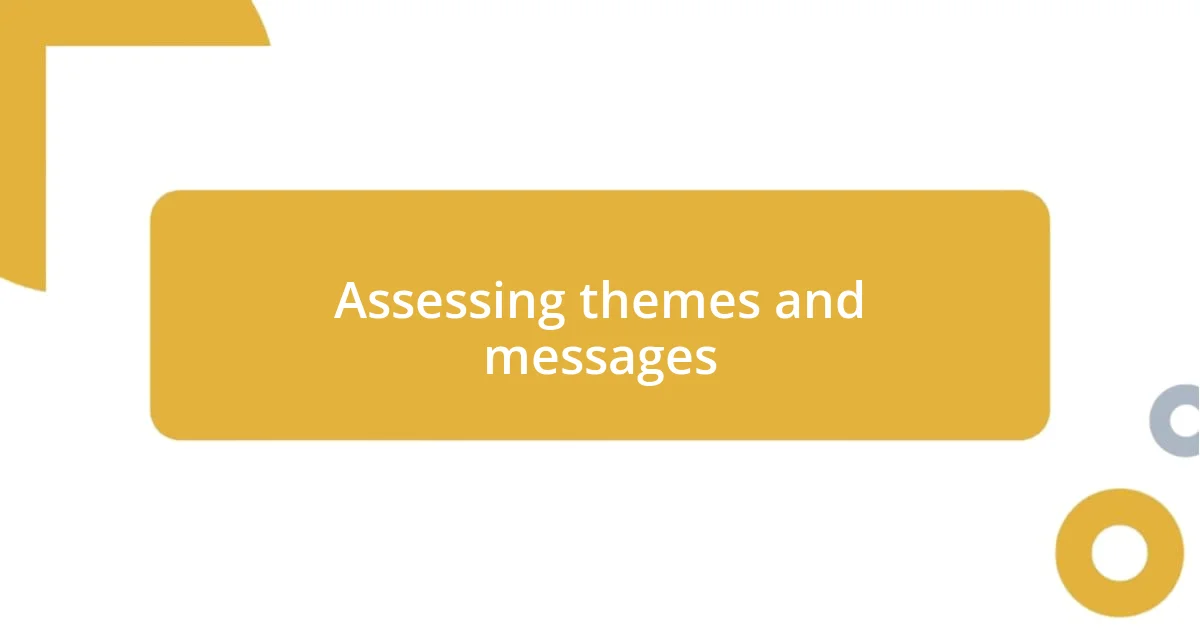
Assessing themes and messages
The themes and messages in dystopian stories often resonate deeply with me, reflecting societal fears and ethical dilemmas that feel alarmingly relevant. For instance, reading 1984 by George Orwell left me feeling a blend of horror and urgency. The concept of surveillance was unsettling, pushing me to question how much privacy I surrender in my own life. Have you ever stopped to consider the depth of your digital footprint? It’s a stark reminder of the thin line between safety and oppression.
I also find it incredibly impactful when authors tackle themes of hope and resistance amid bleak circumstances. In The Dispossessed by Ursula K. Le Guin, the struggle between two contrasting societies made me think about the nature of freedom. The quiet acts of rebellion against authoritarian regimes ignited a flicker of hope in me; it’s a powerful message that change, however small, is always possible. How often do we underestimate our ability to effect change in our communities?
Furthermore, dystopian narratives often force us to confront moral ambiguities that challenge our perceptions of right and wrong. While reading Brave New World by Aldous Huxley, I was struck by the ethical implications of sacrificing individuality for social stability. The characters’ choices made me reflect on the sacrifices we make in our own lives and the values we uphold. Do we accept comfort at the cost of our autonomy? These themes compel us to dig deeper into our own beliefs and the systems we navigate daily.
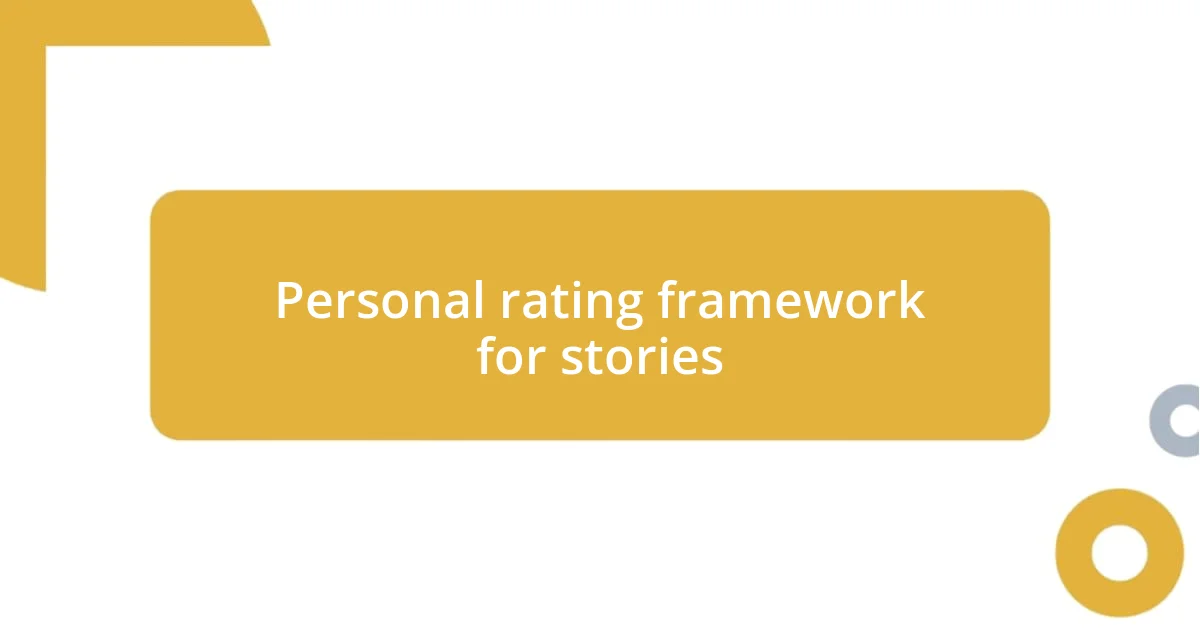
Personal rating framework for stories
When it comes to rating stories, I base my framework on emotional engagement and relatability. I often jot down notes while reading, capturing moments that stir my heart or provoke deep thought. For example, after reading The Parable of the Sower by Octavia Butler, I found myself reflecting on the protagonist’s resilience in the face of adversity long after I turned the last page. Isn’t it fascinating how a single character’s journey can resonate so profoundly with our own experiences?
Another crucial aspect for me is the originality of the premise. I remember diving into Snow Crash by Neal Stephenson and feeling a rush of excitement at how fresh and innovative the ideas felt. The fusion of technology and culture made me reconsider my perception of the future. Don’t you love finding a story that shifts your understanding in unexpected ways? It’s moments like these that enhance my rating and keep me craving more.
Lastly, I pay close attention to character development. If a character feels like a real person with flaws and growth, they immediately score higher in my assessment. While reading The Hunger Games, I was struck by Katniss Everdeen’s evolution from a survivalist to a symbol of resistance. I felt proud of her growth, and I couldn’t help but wonder: how often do we recognize our own potential for growth in challenging times? Stories that make us reflect on our own journey tend to leave a lasting impression on me.
